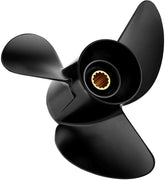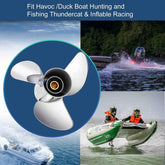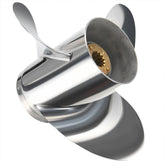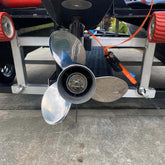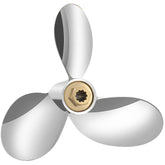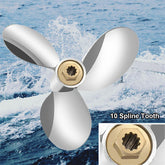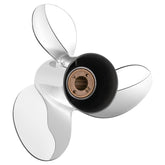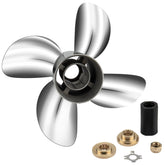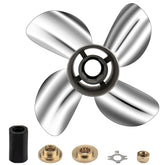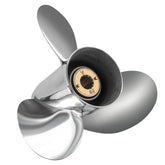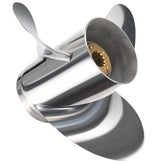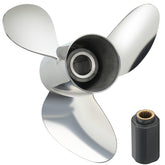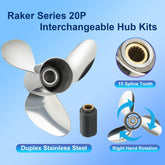Yamaha vs Mercury Boat Propellers: How to Choose a Replacement That Fits Yamaha, Mercury, Honda and Volvo
I write as a propeller technician who spends more days on ramps and in service bays than behind a desk. If you want a replacement prop that actually fits your outboard, performs for how you use the boat, and removes guesswork from the buying process, this guide is for you. It walks you through exact fit checks, the on water test protocol pro tuners use, practical differences between Yamaha and Mercury propellers, starter prop recommendations by horsepower band, a clear troubleshooting playbook, and an ordering path that gets the right prop shipped to you fast from vifprop.com.
We are not Yamaha or Mercury official. We manufacture compatible props that fit the common spline and hub standards used by Yamaha, Mercury, Honda and Volvo. That means you can order a reliable stainless or aluminum prop that fits, but only if you verify the right facts before you buy and run a proper on water test after installation. If you want to learn more about how our propellers are produced and understand the capabilities of our factory, read this article https://vifmarine.com/how-boat-propellers-are-manufactured/
Why compare Yamaha and Mercury propellers now
Yamaha and Mercury dominate the outboard market in North America. Both brands publish prop selector tools and OEM prop lines that are engineered to work with their specific gearcases and torque curves. That engineering is useful, but real boats do not run in dealer test conditions. Real owners carry passengers, coolers, batteries and tow tubes. That changes which prop performs best.
Here are the practical reasons to compare alternatives.
Cost to test
OEM stainless blades often cost so much that owners avoid trying different pitches or blade counts. Factory direct stainless closes that gap so iterative testing becomes realistic.
Fit variety
Some hulls never reached their real best on OEM geometry. Cleavers, cupped trailing edges, higher rake and altered blade area from value manufacturers can unlock faster plane times, better hole shot and a smoother cruise.
Logistics and support
U S inventory and clear compatibility data cut lead times and reduce returns. Fast swap and test keeps boats on the water and reduces downtime.
If your boat is under a dealer warranty that requires OEM parts for coverage, stay with OEM. Otherwise a properly matched aftermarket prop is often the smarter, faster and more cost effective choice.
Quick fit checklist to stop the guesswork
Do not buy a replacement prop until you confirm these items.
Engine make model and year as listed on the transom tag
Gearcase code from the transom tag because different gearcases use different splines and hubs
Spline count and hub type such as Flo Torq style insert or solid splined bore. Verify the SKU lists spline count and hub compatibility
Rotation which means right hand left hand or counter rotating. Do not assume twins are the same
Washer and thrust plate order sequence because order matters and a wrong sequence can cause hub slip and premature wear
If any of these items are unclear pull the prop and photograph the hub and splines then send the photos to the seller for verification. That single step prevents the most common returns.
How Yamaha and Mercury hardware differ in practice
Hardware and hub style
Mercury commonly uses Flo Torq elastomeric insert hubs across many gearcases while Yamaha often uses solid splined bores with distinct spline counts. That means a prop listed as Mercury compatible must specify Flo Torq insert compatibility and the correct spline count. Yamaha fit claims must list the specific spline count and bore style.
Blade geometry tendencies
OEM Yamaha props tend to emphasize smooth midrange torque and steady low speed handling. OEM Mercury props often favor efficient top end and strong hole shot for popular engine families. These are tendencies not absolutes. Aftermarket lines tune rake camber and cupping to push one characteristic or another.
What that means for boaters
If you chase top speed pick a prop with a thinner efficient blade section and lower blade area. If your priority is planing with two or four passengers towing a tube or carrying heavy gear pick a prop with more blade area cupping and possibly a four blade configuration.
The shop rules that actually matter
Pitch is the primary tuning lever
Pitch determines whether the engine will reach its recommended wide open throttle RPM under your normal load.
Diameter controls low end thrust
Larger diameter moves more water per revolution and improves low RPM bite and cavitation margin.
Blade area and blade count trade top speed for bite
More blade area or more blades provides better hole shot and planing for heavy loads. Fewer blades reduce drag and favor top speed.
Cupping and rake are functional not cosmetic
Cupping increases low RPM bite and resists ventilation. Rake affects bow lift and planing behavior.
Slip gives objective feedback
Compute slip on the water to quantify pitch match. Aim for about ten to twenty five percent slip for planing hulls with your normal load.
If a replacement prop does not bring WOT RPM into the correct band for your loaded boat it is the wrong pitch regardless of brand.
Two formulas for practical testing
Use these formulas on test day. Paste them into your phone calculator.
Theoretical speed in miles per hour equals pitch in inches times RPM divided by 336
Slip percentage equals one minus GPS speed divided by theoretical speed times 100
For planing hulls target about ten to twenty five percent slip. Use slip and wide open throttle RPM together to choose pitch and blade area.
On water test protocol used by pro tuners
This is the exact sequence to follow every time you change a prop.
Prepare the boat by removing barnacles setting trim tabs as you normally run and filling the fuel tank to the typical level
Warm the engine to operating temperature because cold running numbers are misleading
Run two to three wide open throttle passes in consistent conditions and average GPS speed and tachometer readings
Compute theoretical speed and slip using the formulas above
Interpret results and change pitch or blade count then repeat
If wide open throttle RPM is below the engine makers recommended band drop pitch by one inch or two and retest
If wide open throttle RPM is above the band increase pitch and retest
If the boat will not plane but RPM is in the band increase blade area by switching to a four blade or a cupped three blade
Iterate by testing one inch changes and a blade count swap until RPM slip and planing feel are right
Always test with your normal load empty boat testing often misleads
Starter prop picks by horsepower band
These are evidence based starting points to order and test. Always verify the SKU on the product page lists your engine model and gearcase code.
Five to fifteen horsepower kickers start with eight by eight three blade aluminum
Twenty to forty horsepower runabouts start with nine by ten three blade aluminum
Fifty to ninety horsepower boats start with eleven and a half inch diameter by fifteen inch pitch stainless as a baseline with an aluminum spare and a four blade to test
One hundred fifteen to one hundred fifty horsepower rigs start with fourteen by nineteen stainless for speed and a four blade for loaded planing
One hundred seventy five to three hundred plus horsepower rigs use fifteen to seventeen inch diameter props with nineteen to twenty five inch pitch Test cleaver and high rake variations for high RPM runs
If budget allows order the OEM baseline and one inch lower pitch or a four blade option to iterate on the water quickly
Aluminum or stainless which fits your mission
Aluminum is a sacrificial spare for shallow launches and debris prone ramps. It bends before it transfers excessive energy to the lower unit. Aluminum blades are thicker which reduces peak efficiency.
Stainless allows thinner more hydrodynamic blade sections for real top end and cruise gains. Stainless holds an edge longer but transfers impact energy to the lower unit.
Factory direct pricing makes stainless testing realistic. My practical recommendation is daily stainless with an aluminum spare on the trailer.
Blade count decisions that affect everyday performance
Three blade provides the highest potential top speed for a given pitch and diameter
Four blade increases blade area improving hole shot and planing under load at the expense of a small top speed loss
Cleaver and high rake three blade options are for high RPM runs and require correct gearcase clearance and gearing
If your boat is slow to plane with a normal load and wide open throttle RPM is in the band switch to a four blade and retest You will usually plane faster and see better usable speed
Prop hub types and the most common buyer traps
Buyers commonly assume a fits claim covers all models which it does not. A fit claim needs to list the gearcase codes and spline counts.
Other traps include ordering the wrong rotation and ignoring the thrust washer and spacer sequence. Wrong washer order can cause hub slip.
Simple rule photograph the hub and spline count and match those facts to the product compatibility matrix.
Diagnostic playbook for strikes spun hubs bent blades and lower unit damage
If you strike something stop the engine and shift to neutral immediately
Inspect and photograph blades hub splines and lower unit Photographs speed up shop estimates and warranty claims
Check lower unit oil for metal flakes or milky color If you find either do not run the engine and tow to a service shop
Symptom decode
Engine revs but boat will not move equals spun hub or stripped splines
Vibration at cruise equals bent blade or imbalance
Grinding noises and metal in oil equals gearset or bearing failure
Loss of top speed with normal RPM equals blade deformation or heavy fouling
DIY triage remove the prop inspect the elastomeric hub replace inserts if shredded check shaft straightness on a bench and measure prop runout with a dial indicator Small bends on aluminum props can often be straightened and rebalanced
If splines are stripped or shaft is bent or stainless is cracked call a professional
Typical cost ranges include hub insert kits fifteen to sixty dollars aluminum straightening and balancing thirty to eighty dollars stainless replacement two hundred to seven hundred dollars and lower unit rebuilds five hundred to three thousand five hundred dollars
Keep a spare aluminum prop and a hub kit in the trailer to avoid weekend failures
Why factory direct manufacturing matters for testing and tuning
Factory direct pricing often reduces stainless cost thirty to fifty percent below OEM. CNC finishing and dynamic balancing increase consistency. U S warehousing and a one hundred eighty day warranty reduce lead time and return friction.
For competitive anglers fleet managers and rental operators buying several stainless test props and iterating on the water is the fastest route to a truly tuned setup and now it is affordable.
If you want to learn more about how our boat propellers are produced and understand the capabilities of our factory read this manufacturing article https://vifmarine.com/how-boat-propellers-are-manufactured/
How to use Yamaha and Mercury prop selector tools correctly
Manufacturer prop selectors are starting points not final answers
Use Yamaha and Mercury selectors to find the OEM baseline for your engine and boat type Record stock diameter pitch blade count and gearcase code
Order the baseline for guaranteed fit then order one inch lower pitch or a different blade count and test both with your normal load
Select the prop that lands wide open throttle RPM in the recommended band while delivering acceptable slip and planing feel
Your actual load and hull condition are the final judges not the selector recommendation
Exact steps to order the right prop on vifprop.com
Pull the current prop and photograph the hub and splines or copy transom tag data
Go to vifprop.com and review the product compatibility matrix on the product page
Confirm engine model gearcase code and spline count match the SKU Use live chat and upload photos for verification if needed
Add the baseline prop plus one inch lower pitch or a four blade variant to the cart and include an aluminum spare if you run shallow
Choose U S warehouse shipping at checkout for fastest delivery
When the props arrive install the baseline and run the on water test routine Keep packaging until you are satisfied in case you need to return under warranty
Ordering two props up front saves time and reduces multiple returns
Frequently asked questions answered by a prop technician
Will a compatible prop damage my Mercury lower unit
Not if you pick the correct SKU that matches gearcase code and spline count. Damage comes from impacts wrong washer order and contaminated oil not from a properly matched prop.
How fast will it ship
Choose U S warehouse shipping at checkout. Most orders ship same or next business day and delivery times are shown at checkout.
What if I order the wrong prop
Vifprop offers a clear returns policy and a one hundred eighty day manufacturing warranty Keep packaging and document fit attempts Use live chat for quick help.
Can I test stainless and return the one I do not want
Yes keep the prop unused in its packaging and follow return instructions.
Does VIF support Flo Torq type hubs and common Yamaha splines
Yes each SKU lists hub compatibility including Flo Torq style inserts or splined bore and spline count Confirm engine and gearcase code before ordering.
Final expert checklist take action now
Photograph your transom tag and old prop hub
Confirm engine model and gearcase code
Order the OEM baseline and one inch lower pitch stainless or a four blade variant plus an aluminum spare at vifprop.com Select U S warehouse shipping
Run two to three wide open throttle passes with your normal load and compute slip
Keep the packaging and photos until you are satisfied and use support chat if anything looks off
Keep a spare prop and a hub insert kit on the trailer to avoid weekend failures
If you want immediate help selecting the exact SKU paste transom data and a photo of the old prop hub into vifprop.com site chat Support will confirm the correct product before you check out


